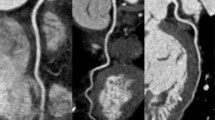Abstract
The purpose of this study was to compare coronary 64-slice CT angiography (CTA) protocols, specifically prospective electrocardiograph (ECG)-triggered and retrospective ECG-gated CT acquisition performed using a tube voltage of 140 kV and 120 kV, regarding intracoronary stent imaging. Coronary artery stents (n = 12) with artificial in-stent restenosis (50% luminal reduction, 40 HU) on a cardiac phantom were examined by CT at heart rates of 50–75 beats per minute (bpm). The subjective visibility of in-stent restenosis was evaluated with a three-point scale (1 clearly visible, 2 visible, and 3 not visible), and artificial lumen narrowing [(inner stent diameter − measured lumen diameter)/inner stent diameter], lumen attenuation increase ratio [(in-stent attenuation − coronary lumen attenuation)/coronary lumen attenuation], and signal-to-noise ratio of in-stent lumen were determined. The effective dose was estimated. The artificial lumen narrowing (mean 43%), the increase of lumen attenuation (mean 46%), and signal-to-noise ratio (mean 7.8) were not different between CT acquisitions (p = 0.12–0.91). However, the visibility scores of in-stent restenosis were different (p < 0.05) between ECG-gated CTA techniques: (a) 140-kV prospective (effective dose 4.6 mSv), 1.6; (b) 120-kV prospective (3.3 mSv), 1.8; (c) 140-kV retrospective (16.4–18.8 mSv), 1.9; and (d) 120-kV retrospective (11.0–13.4 mSv), 1.9. Thus, 140-kV prospective ECG-triggered CTA improves coronary in-stent restenosis visibility at a lower radiation dose compared with retrospective ECG-gated CTA.









Similar content being viewed by others
References
Scanlon PJ, Faxon DP, Audet AM et al (1999) ACC/AHA guidelines for coronary angiography: a report of the American College of Cardiology/American Heart Association Task Force on Practice Guidelines (Committee on Coronary Angiography) developed in collaboration with the Society for Cardiac Angiography and Interventions. J Am Coll Cardiol 33:1756–1824
Hamon M, Champ-Rigot L, Morello R, Riddell JW, Hamon M (2008) Diagnostic accuracy of in-stent coronary restenosis detection with multislice spiral computed tomography: a meta-analysis. Eur Radiol 18:217–225
Schuijf JD, Pundziute G, Jukema JW et al (2007) Evaluation of patients with previous coronary stent implantation with 64-section CT. Radiology 245:410–423
Das KM, El-Menyar AA, Salam AM et al (2007) Contrast-enhanced 64-section coronary multidetector CT angiography versus conventional coronary angiography for stent assessment. Radiology 245:424–432
Carrabba N, Bamoshmoosh M, Carusi LM et al (2007) Usefulness of 64-slice multidetector computed tomography for detecting drug eluting in-stent restenosis. Am J Cardiol 100:1754–1758
Hecht HS, Zaric M, Zaric V, Lubarsky L, Prakash M, Roubin G (2008) Usefulness of 64-detector computed tomographic angiography for diagnosing in-stent restenosis in native coronary arteries. Am J Cardiol 101:820–824
Manghat N, Lingen RV, Hewson P et al (2008) Usefulness of 64-detector row computed tomography for evaluation of intracoronary stents in symptomatic patients with suspected in-stent restenosis. Am J Cardiol 101:1567–1573
Suzuki J, Furui S, Kuwahara S et al (2007) Assessment of coronary stent in vitro on multislice computed tomography angiography: improved in-stent visibility by the use of 140-kV tube voltage. J Comput Assist Tomogr 31:414–421
Horiguchi J, Kiguchi M, Fujioka C et al (2008) Radiation dose, image quality, stenosis measurement, and CT densitometry using ECG-triggered coronary 64-MDCT angiography. A Phantom Study AJR 190:315–320
Hirai N, Horiguchi J, Fujioka C et al (2008) Prospective electrocardiography-triggered versus retrospective electrocardiography-gated 64-slice coronary CT angiography: image quality, stenoses assessment and radiation dose. Radiology 248:424–430
Hsieh J, Londt J, Vass M, Li J, Tang X, Okerlund D (2006) Step-and-shoot data acquisition and reconstruction for cardiac x-ray computed tomography. Med Phys 33:4236–4248
Cademartiri F, Mollet N, Lemos PA et al (2005) Usefulness of multislice computed tomographic coronary angiography to assess instent restenosis. Am J Cardiol 96:799–802
Maintz D, Seifarth H, Raupach R et al (2006) 64-slice multidetector coronary CT angiography: in vitro evaluation of 68 different stents. Eur Radiol 16:818–826
Seifarth H, Özgün M, Raupach R et al (2006) 64- versus 16-slice CT angiography for coronary artery stent assessment. In vitro experience. Invest Radiol 41:22–27
Seifarth H, Raupach R, Schaller S et al (2005) Assessment of coronary artery stents using 16-slice MDCT angiography: evaluation of a dedicated reconstruction kernel and a noise reduction filter. Eur Radiol 15:721–726
Menzel H, Schibilla H, Teunen D(eds) (2000) European guidelines on quality criteria for computed tomography. European Commission, Luxembourg. Available at http://www.drs.dk/guidelines/ct/quality/index.htm. Accessed Dec 2008
Cohen J (1960) A coefficient of agreement for nominal scales. Educ Psychol Meas 20:37–46
Barrett JF, Keat N (2004) Artifacts in CT: recognition and avoidance. RadioGraphics 24:1679–1691
Husmann L, Valenta I, Gaemperli O (2008) Feasibility of low-dose coronary CT angiography: first experience with prospective ECG-gating. Eur Heart J 29:191–197
Groen JM, Greuter MJW, van Ooijen PMA, Willems TP, Oudkerk M (2006) Initial results on visualization of coronary artery stents at multiple heart rates on a moving heart phantom using 64-MDCT. JCAT 30:812–817
Boll DT, Merkle EM, Paulson EK, Fleiter TR (2008) Coronary stent patency: dual-energy multidetector CT assessment in a pilot study with anthropomorphic phantom. Radiology 247:687–695
Mahnken AH, Seyfarth T, Flohr T et al (2005) Flat-panel detector computed tomography for the assessment of coronary artery stents: phantom study in comparison with 16-slice spiral computed tomography. Invest Radiol 40:8–13
Rybicki FJ, Otero HJ, Steigner ML et al (2008) Initial evaluation of coronary images from 320-detector row computed tomography. Int J Cardiovasc Imaging 24:535–546
Acknowledgements
This study was financially supported by the Tsuchiya Foundation (http://www.tsuchiya-foundation.or.jp), Hiroshima, Japan.
Author information
Authors and Affiliations
Corresponding author
Rights and permissions
About this article
Cite this article
Horiguchi, J., Fujioka, C., Kiguchi, M. et al. Prospective ECG-triggered axial CT at 140-kV tube voltage improves coronary in-stent restenosis visibility at a lower radiation dose compared with conventional retrospective ECG-gated helical CT. Eur Radiol 19, 2363–2372 (2009). https://doi.org/10.1007/s00330-009-1419-1
Received:
Accepted:
Published:
Issue Date:
DOI: https://doi.org/10.1007/s00330-009-1419-1




